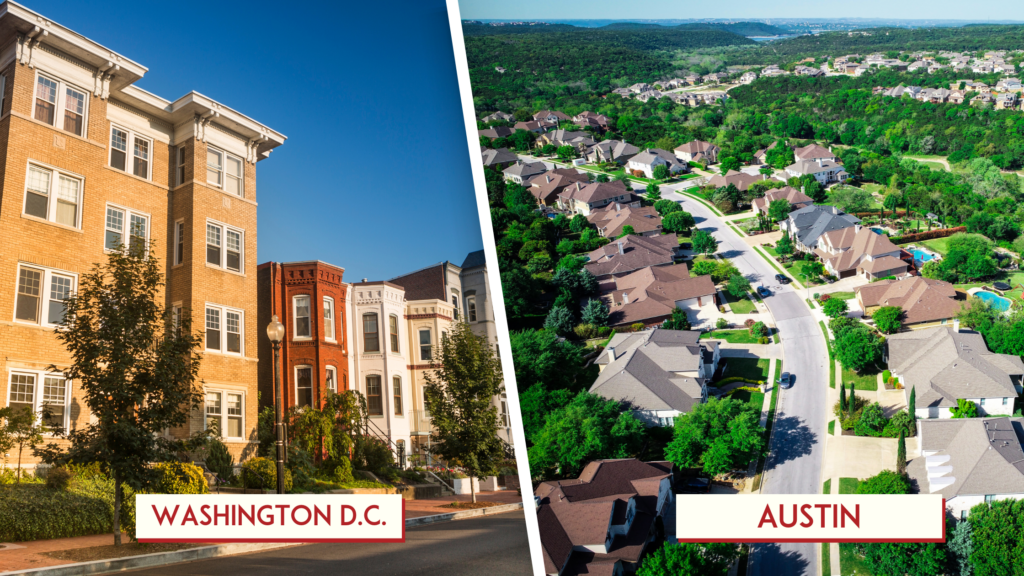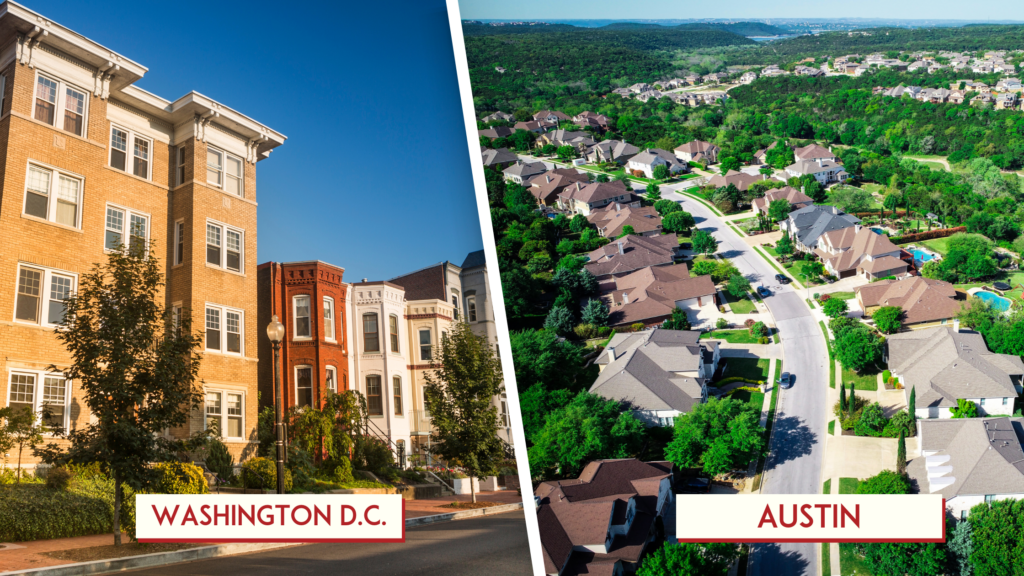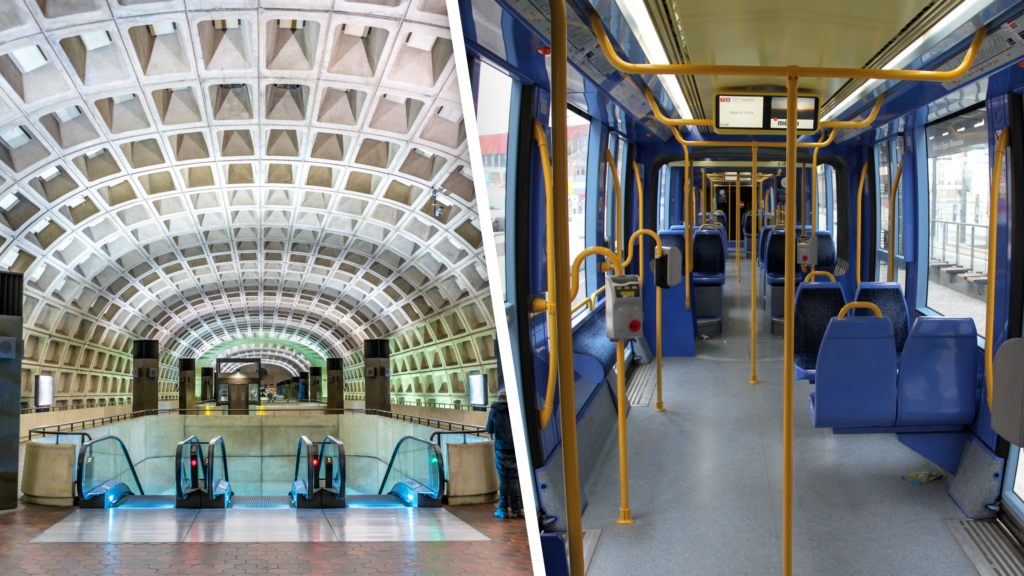
Let’s not going to sugarcoat it – moving to Austin from Washington DC is a big deal. It’s like trading in your stuffy suit for a pair of cowboy boots and a “Keep Austin Weird” t-shirt. But here’s the thing, y’all: it’s not just about the change of scenery. Moving to Austin from Washington DC is about embracing a whole new way of life.
Imagine leaving behind the hustle and bustle of politics and traffic in D.C. for Texas, where you can enjoy chill vibes and delicious BBQ. It’s a chance to reinvent yourself in a city brimming with creativity, innovation, and quirky charm.
So you’re planning a big move from Washington D.C. to Austin? Buckle in because it’s going to be one wild ride filled with surprises and excitement every step of the way.
Table of Contents
Comparing the Cost of Living Between Austin and Washington DC

Moving from DC to Austin made me really think about the cost of living. It’s a mixed bag here; some stuff is cheaper, but other things can surprise you with how pricey they are. Let’s break it down.
Housing Costs
Housing costs are a significant factor when comparing the cost of living between Austin and Washington DC. According to recent data, the median home price in Austin is around $664,500, while in DC it is closer to $625,000.
Renting a studio apartment in Austin averages about $1,248 per month, compared to $1,814 or more in DC. This is according to the May 2024 data from Apartments.com.
Transportation Expenses
Transportation expenses also vary between the two cities. Austin has lower gas prices and car insurance rates than DC. However, DC has a more extensive public transportation system, which can save money for those who don’t own a car.
A monthly transit pass in DC costs about $75, while in Austin a monthly pass for the more limited bus system is around $45.
Grocery and Dining Prices
When it comes to food costs, grocery prices in Austin are about 16.9% lower than D.C. Dining out is also more affordable in Austin, with a mid-range restaurant meal for two averaging $80, compared to $100 in DC. However, both cities offer a wide range of cuisine options at various price points.
Planning Your Move from DC to Austin
Planning is everything. You’ve got to decide how you’re going to get your stuff there, whether you’re going to hire movers or do it yourself, and budget for all the costs. It’s a lot to think about, but we’re here to help.

Choosing a Moving Company
When planning a move from D.C. to Austin, selecting a reputable moving company is crucial. Research and compare quotes from several companies, looking at factors such as pricing, services offered, insurance coverage, and customer reviews.
DIY Moving Options
For those looking to save money on their move, DIY options like renting a moving truck or using a moving container service can be more affordable than hiring a full-service moving company. U-Haul, Budget Truck Rental, and Penske Truck Rental are some well-known truck rental companies. Moving container companies like PODS and U-Pack provide more flexibility, dropping off a container that you load yourself and then transporting it to your new home.
Estimating Your Moving Costs
The cost of moving from DC to Austin will depend on factors such as the amount and type of belongings you’re moving, the distance, and any additional services needed (packing, storage, etc.). On average, a long-distance move for a 2-3 bedroom home can range from $4,000 to $8,000 or more. To get the most accurate estimate, request in-home or virtual surveys from moving companies and provide detailed inventories.
Navigating the Austin Housing Market
Once you’ve made the move to Austin, finding a place to call home is the next big challenge. Whether you’re renting or buying, it’s important to understand the local housing market dynamics and renting vs. homeownership.

Buying a Home in Austin
For those looking to buy a home in Austin, the market has been competitive, with low inventory and rising prices. As of 2021, the median home price in Austin was around $450,000, up from $350,000 just a few years prior. Popular neighborhoods for buyers include Mueller, Avery Ranch, and Circle C Ranch, but prices can vary widely depending on location and home type. Working with a local real estate agent is recommended to navigate the market.
Getting Around Austin: Transportation Options
Austin has a variety of transportation options, though it is generally considered a car-dependent city. The Capital Metro bus system covers much of the city, with fares starting at $1.25 per ride. The MetroRail commuter train serves nine stations from Leander to Downtown Austin.

For those who prefer to bike, Austin has over 200 miles of bike lanes and trails. Ride-sharing services like Uber and Lyft are also widely available, which can impact transportation expenses.
Budgeting for Utilities and Services in Austin
Don’t forget to factor in utility costs when budgeting for your move to Austin. While some expenses may be lower than in DC, others can add up quickly.

Electricity and Gas Prices
Utility costs in Austin are relatively affordable compared to other major cities. According to Energy Sage, the average monthly residential electricity bill is around $152. Natural gas, provided by Texas Gas Service, averages about $30 per month. However, prices can vary depending on home size, energy usage, and time of year, with higher costs in the summer months due to air conditioning.
Water and Sewer Rates
Water and sewer services in Austin are provided by Austin Water. The average monthly residential water bill is around $30, with sewer charges adding another $30-$40. Rates are tiered based on usage, so conserving water can help keep bills low. Austin also has some of the highest water quality in the state, with regular testing and treatment.
Internet and Cable Providers
Austin has several options for internet service essentials and cable services, including AT&T, Spectrum, and Google Fiber. Prices and availability vary by location, but on average, expect to pay around $50-$70 per month for high-speed internet and $50-$100 or more for cable TV packages. Many providers offer bundle deals for combined services. It’s worth comparing plans and promotions from multiple providers to find the best fit for your needs and budget.
Exploring Austin’s Food Scene
The food scene here is fantastic, offering everything from gourmet restaurants to quirky food trucks. You’ll never run out of local dishes and new flavors to try.

Grocery Store Chains in Austin
Austin has a variety of grocery store chains, including major national retailers like Whole Foods (which was founded in Austin), Trader Joe’s, and Costco, as well as regional chains like H-E-B and Central Market.
Grocery prices are generally lower than in DC, with budget-friendly options like Aldi and Walmart also available. Many stores offer organic and locally-sourced products, reflecting Austin’s focus on sustainability and supporting local businesses.
Popular Restaurants and Cuisines
In Austin, you’ll find an exciting mix of cuisines that cater to every palate and budget. If you’re after legendary brisket, head over to Franklin Barbecue. Tacos more your thing? Veracruz All Natural has got you covered with their authentic flavors. Sushi lovers will enjoy the upscale offerings at Uchi too.
Don’t miss out on the city’s vibrant food truck culture either—Valentina’s Tex Mex BBQ and East Side King are must-tries. And good news: eating out here costs less than in DC; around $50 gets you dinner for two at most mid-range spots.
Enjoying Austin’s Leisure and Entertainment Activities
Austin has plenty of fun and affordable activities. Music lovers can catch live shows at the Continental Club or Stubb’s BBQ, featuring both local bands and big names. If you prefer outdoor adventures, Barton Springs Pool offers hiking and swimming without breaking the bank.

Film buffs will enjoy indie flicks at Alamo Drafthouse or a night out at iPic Theater for the latest blockbusters. While some events like VIP concerts might be pricey, overall entertainment in Austin won’t empty your wallet.
Understanding Childcare Costs in Austin
For families with children, child care costs are a significant expense, with the average cost of full-time center-based care for an infant in Austin around $1,400 per month, slightly lower than DC’s average of $2,200. However, costs can vary widely depending on location and type of care.
Finding Employment and Earning a Living in Austin
Austin has a strong and diverse job market, with major employers in industries like technology, healthcare, and education. The city’s unemployment rate is consistently lower than the national average, and job growth has been steady in recent years.

However, salaries in Austin are generally lower than in DC, with the median household income around $71,000, compared to $86,000 in DC. Cost of living is also lower in Austin, which can help offset the salary difference for some professions, making it easier to make ends meet.
Settling into Your New Life in Austin
Relocating to Austin comes with its own set of excitement and hurdles, but the city provides numerous tools for newcomers looking to get comfortable quickly. Choosing the right area that aligns with how you live and what you can afford makes all the difference.
Thanks to its open-minded community, building a new life here feels natural. Social networks like Facebook or Reddit can connect you with fellow transplants ready to share insights about jobs or places to live.
Making the Move to Austin from Washington D.C.
Moving to Austin from Washington DC isn’t for the faint of heart. It takes guts, grit, and a whole lot of gumption to pack up your life and start anew in the heart of Texas.
But if you’re willing to take the leap, Austin will welcome you with open arms. You’ll find a community of like-minded individuals who value creativity, individuality, and a damn good time. You’ll discover a city that’s constantly evolving, with new restaurants, music venues, and start-ups popping up on every corner. If you’re considering moving to Austin from D.C., submit the form below to speak with a relocation specialist!





